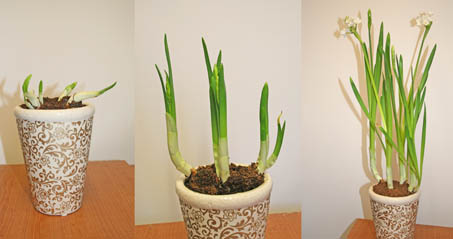Flowering bulbs typically herald the coming of spring. By using a technique called “forcing bulbs,” you can enjoy many springtime bulbs during the winter, too.
“My first Christmas in Ringold (Ga.) I bought amaryllis bulbs and held a contest with the ladies in the Extension office,” said Charles Lancaster, a University of Georgia Cooperative Extension agent in Catoosa County. “I bought bulbs in four colors, and we each picked one.”
Watch and wait
Over the next few weeks, the office staff waited and then watched as the stalks began to emerge.
“We all had a great time watching and waiting as our plant blossomed and brought a little sunshine inside our office during the short days of winter,” he said.
Planted now, bulbs may not bloom before Christmas, but you and your family can still watch as they grow in the coming weeks.
From tulips to daffodils
Bulbs can be forced to bloom indoors earlier than they normally would outdoors. Crocus, galanthus, hyacinth, narcissus, daffodil, scilla and tulip are the easiest to force.
Pot the bulbs in October or November using a well-drained soil. The number of bulbs per pot will vary according to pot and bulb size.
Keep them in the dark at about 40 degrees F for 8 to 12 weeks in a cold frame outdoors, an unheated garage or basement, or in your refrigerator. (The bulbs must not be allowed to freeze.) Do not allow the soil in the pots to dry out.
After two or three months, the root system should be extensively developed, and shoots will start to emerge from the bulbs. Place the pots in a cool, bright room at about 55 degrees. If possible, place them in a southern window. Eastern or western windows are second best.
Poor light = weak stems
Once shoots emerge, bulbs will produce blooms in about one month. High temperatures and/or poor light will cause spindly, weak stems.
Crocus, hyacinth, narcissus, and tulip bulbs can be refrigerated at 40 degrees for two months prior to planting, then potted and forced. The results are not usually as satisfactory because the root systems don’t have enough time to fully develop.
Lancaster says most forced bulbs will seldom grow and flower well when replanted in the garden.
Amaryllis can grow indoors and out
“Amaryllis bulbs will do okay planted outside, but the flower color will be different than when it’s grown indoors,” he said.
According to UGA Extension horticulturist Bodie Pennisi, when amaryllis blooms fade indoors, cut the bloom stalk off near the soil surface. Sometimes a bulb will send up a second stalk.
When the blooms are gone, allow the leaves to remain on the plant, she said. Keep it in a sunny window until May and then plant it outdoors.
Amaryllis will grow in almost any well-drained soil as long as they receive adequate moisture and some shade.








